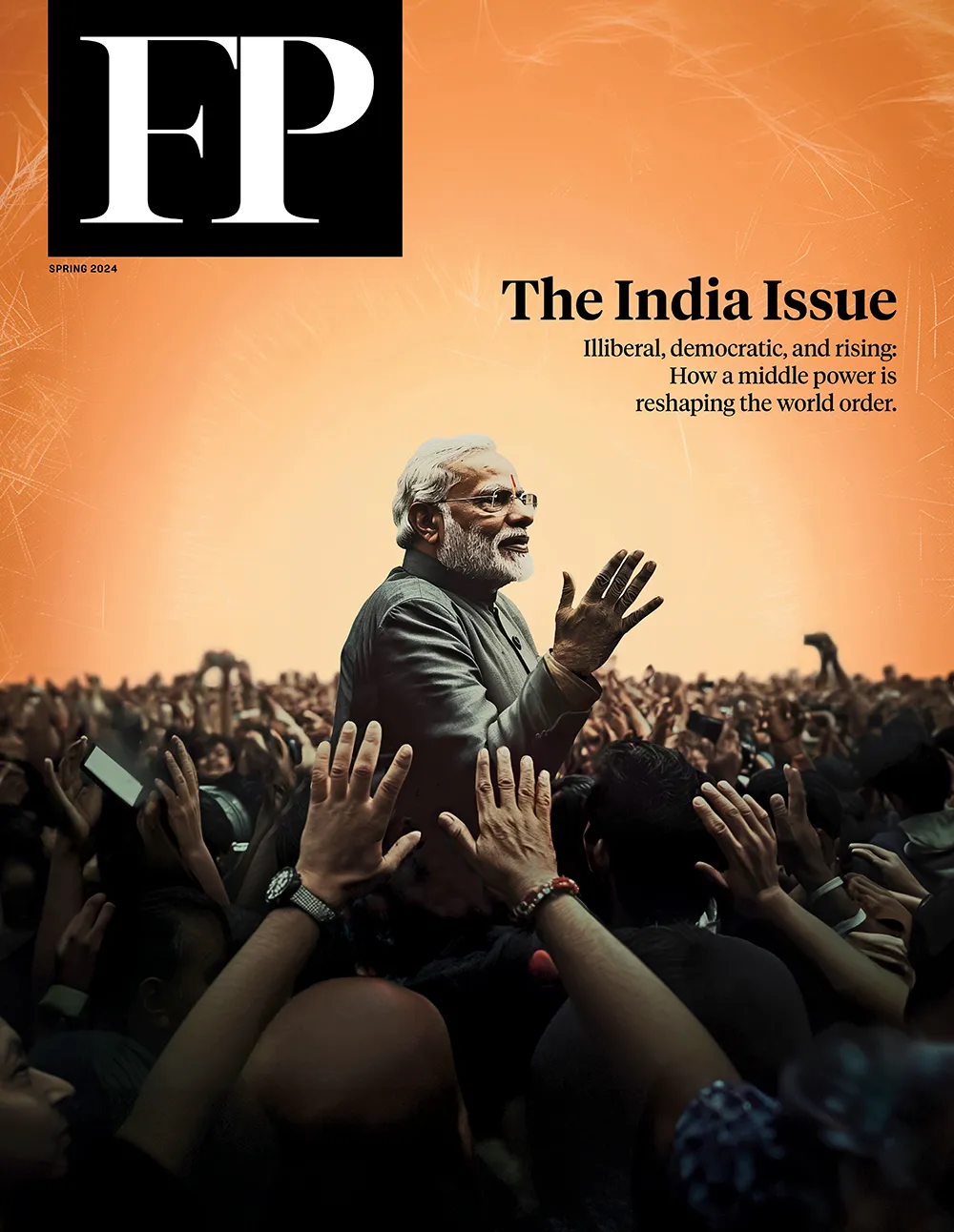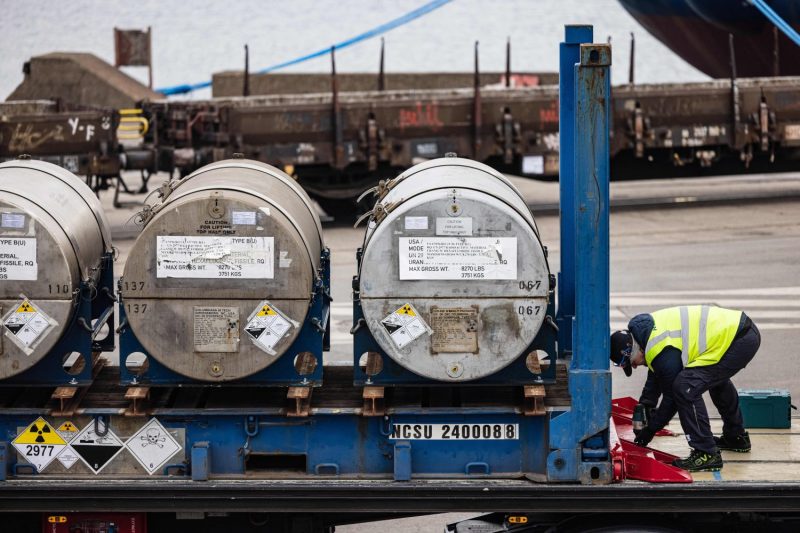Gazprom’s Declining Fortunes Spell Trouble for Moscow
The gas giant’s record loss should worry the Kremlin on several fronts.
At the end of 2022, Dmitry Medvedev—Russia’s former prime minister and the current deputy chairman of its Security Council—offered his predictions for the coming year. He warned that Europeans would suffer badly from Russia’s decision to curb natural gas exports to the European Union, suggesting that gas prices would jump to $5,000 per thousand cubic meters in 2023—around 50 times their prewar average. He probably assumed that that sky-high prices would translate into a windfall for Russian state-owned energy company Gazprom, which was still supplying several European countries via pipeline, ramping up exports of liquefied natural gas, and eyeing new deals with China. Perhaps Medvedev also hoped that Europeans would beg the Kremlin to send the gas flowing again.
At the end of 2022, Dmitry Medvedev—Russia’s former prime minister and the current deputy chairman of its Security Council—offered his predictions for the coming year. He warned that Europeans would suffer badly from Russia’s decision to curb natural gas exports to the European Union, suggesting that gas prices would jump to $5,000 per thousand cubic meters in 2023—around 50 times their prewar average. He probably assumed that that sky-high prices would translate into a windfall for Russian state-owned energy company Gazprom, which was still supplying several European countries via pipeline, ramping up exports of liquefied natural gas, and eyeing new deals with China. Perhaps Medvedev also hoped that Europeans would beg the Kremlin to send the gas flowing again.
It turns out that Medvedev might want to polish his crystal ball: Last year, European gas prices averaged a mere one-tenth of his number. And just this month, Gazprom posted a massive $6.8 billion loss for 2023, the first since 1999.
Gazprom’s losses demonstrate the extent to which the Kremlin’s decision to turn off the gas tap to Europe in 2022 has backfired. In 2023, European Union imports of Russian gas were at their lowest level since the early 1970s, with Russian supplies making up only 8 percent of EU gas imports, down from 40 percent in 2021. This has translated into vertiginous losses for Gazprom, with the firm’s revenues from foreign sales plunging by two-thirds in 2023.
Gazprom’s woes are very likely setting off alarm bells in Moscow: With no good options for the company to revive flagging gas sales, its losses could weigh on Russia’s ability to finance the war in Ukraine. This is especially ironic given the fact that EU sanctions do not target Russian gas exports; the damage to the Kremlin and its war effort is entirely self-inflicted.
The most immediate impact of Gazprom’s losses will be on Russian government revenues, a crucial metric to gauge Moscow’s ability to sustain its war against Ukraine. Poring over Gazprom’s latest financials paints a striking picture. Excluding dividends, Gazprom transferred at least $40 billion into Russian state coffers in 2022, either to the general government budget or the National Welfare Fund (NWF), Moscow’s sovereign wealth fund.
This is no small feat. Until last year, Gazprom alone provided about 10 percent of Russian federal budget revenues through customs and excise duties as well as profit taxes. (Oil receipts usually account for an additional 30 percent of budget revenues.) This flood of money now looks like distant history. In 2023, the company’s contribution to state coffers through customs and excise duties was slashed by four-fifths, and like many money-losing firms, it is due a tax refund from the Russian treasury.
For Moscow, this is bad news on several fronts. Because of rising military expenses, the country’s fiscal balance swung into deficit when Moscow invaded Ukraine. To help plug the gap, the Kremlin ordered Gazprom to pay a $500 million monthly levy to the state until 2025. Now that the company is posting losses, it is unclear how it will be able to afford this transfer. In addition, Gazprom’s contribution to the NWF will probably have to shrink. For the Kremlin, this could not come at a worst time: The NWF’s liquid holdings have already dropped by nearly $60 billion, around half of its prewar total, as Moscow drains its rainy-day fund to finance the war. Finally, Gazprom’s woes could prompt the firm to shrink its planned investments in gas fields and pipelines—a decision that would, in turn, hit Russian GDP growth.
As if this was not enough, a closer look at Gazprom’s newly released financials suggests that the worst may be yet to come, with three telltale signs that 2024 could be even more difficult than 2023.
First, Gazprom’s accounts receivable—a measure of money due to be paid by customers—are in free fall, suggesting that the firm’s revenue inflow is drying up. Second, accounts payable shot up by around 50 percent in 2023, hinting that Gazprom is struggling to pay its own bills to various suppliers. Finally, short-term borrowing nearly doubled last year as Russian state-owned banks were enlisted to support the former gas giant.
Whereas these figures come from Gazprom’s English-language financials, the company’s latest Russian-language update yields two additional surprises—both of which show that the firm’s situation has worsened even further since the beginning of the year.
First, short-term borrowing during the first three months of 2024 roughly doubled compared to the previous quarter. If Russian state-owned banks continue to cover Gazprom’s losses, the Russian financial sector could soon find itself in trouble. This begs a tricky question: With the NWF’s reserves dwindling and Moscow’s access to international capital markets shut down, who would pay a bailout bill? Second, Gazprom’s losses were almost five times greater in the first quarter of 2024 than in the same period of 2023, hinting that the firm may post an even bigger loss this year than it did in 2023.
Looking ahead, 2025 will be an especially tough year for Gazprom. The transit deal for gas shipments through Ukraine via pipeline to Austria, Hungary, and Slovakia will probably expire at the end of this year, further curbing what’s left of Gazprom’s exports to Europe. A quick glance at a map makes it clear that China is now the only remaining option for Russian pipeline gas.
Yet Beijing is not that interested: Last year, it bought just 23 billion cubic meters of Russian gas, a mere fraction of the 180 billion cubic meters that Moscow used to ship to Europe. Negotiations to build the Power of Siberia 2 pipeline, which would boost gas shipments to China, have stalled. And in truth, China is not a like-for-like replacement for Gazprom’s lost European consumers. Beijing pays 20 percent less for Russian gas than the remaining EU customers, and the gap is predicted to widen to 28 percent through 2027.
Without pipelines, raising exports of liquefied natural gas (LNG) is the only remaining option for Moscow. However, Western policies make this easier said than done. Western export controls curb Russia’s access to the complex machinery needed to develop LNG terminals, such as equipment to chill the gas to negative 160 degrees Celsius so that it can be shipped on specialized vessels. In addition, Washington has recently imposed sanctions on a Singapore-based firm and two ships working on a Russian LNG project, signaling that it will similarly designate any entity willing to work in the sector. Finally, U.S. sanctions make it much harder for Russian firms to finance the development of new liquefaction facilities and the gas field designed to supply them. In December, Japanese firm Mitsui announced that it was pulling staff and reviewing options for its participation to Russia’s flagship Arctic LNG 2 project. As a result, the Russian operator announced last month that it was suspending operations of the project, which was originally slated to launch LNG shipments early this year.
Gazprom’s cheesy corporate slogan—“Dreams come true!”—does not ring so true anymore as Moscow’s former cash cow becomes a loss-making drain. Data from the International Energy Agency confirms the extent of the Kremlin’s miscalculation when it turned off the gas tap to Europe: The agency predicts that Russia’s share of global gas exports will fall to 15 percent by 2030—down from 30 percent before Moscow’s full-blown invasion of Ukraine.
This was probably predictable. It is hard to imagine how a gas exporter configured to serve European customers and reliant on Western technology could thrive after refusing to serve its main client—signaling to every other potential customer, including China, that it is an unreliable supplier. Corporate empires tend to rise and fall, and it looks like Gazprom will be no exception to the rule.
Agathe Demarais is a columnist at Foreign Policy, a senior policy fellow on geoeconomics at the European Council on Foreign Relations, and the author of Backfire: How Sanctions Reshape the World Against U.S. Interests. Twitter: @AgatheDemarais
More from Foreign Policy

The Man Who Tried to Save Israel From Itself
This time, Israel must heed Theodor Meron’s warning.

‘Somalia on Steroids’: Sudan Conflict Escalates
The U.S. special envoy for Sudan warns that the geopolitical fallout from the spiraling civil war could be immense.

Biden’s Foreign-Policy Problem Is Incompetence
The U.S. military’s collapsed pier in Gaza is symbolic of a much bigger issue.

Why Is Xi Not Fixing China’s Economy?
Explanations from insiders range from ignorance to ideology.







Join the Conversation
Commenting on this and other recent articles is just one benefit of a Foreign Policy subscription.
Already a subscriber? .
Subscribe Subscribe
View Comments
Join the Conversation
Join the conversation on this and other recent Foreign Policy articles when you subscribe now.
Subscribe Subscribe
Not your account?
View Comments
Join the Conversation
Please follow our comment guidelines, stay on topic, and be civil, courteous, and respectful of others’ beliefs.